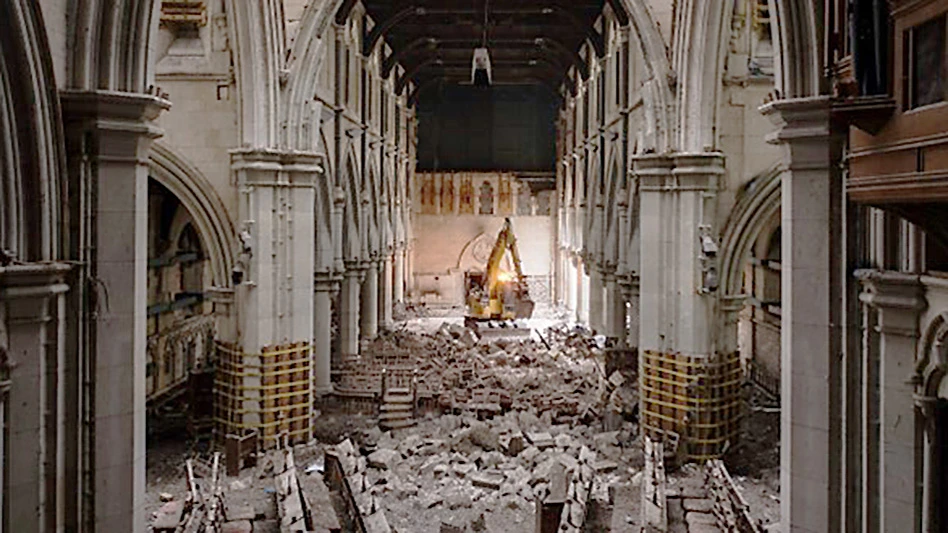
Photo courtesy of Protranz Earthmoving
At 12:51 p.m. Feb. 22, 2011, Christchurch City, New Zealand, felt the force of a magnitude 6.2 earthquake that damaged buildings throughout the city. The Christ Church Anglican Cathedral, an iconic structure in the city, was not immune to this destruction.
After years of consultation, onsite reinstatement work began in May 2020. Workers needed to remove the debris to facilitate structural strengthening inside the cathedral; however, until the strengthening work was completed, it was unsafe to enter the cathedral. A remote-control excavator solved this conundrum.
At the 2022 World Demolition Summit, Nov. 16-17 in Vienna, Christchurch-based Protranz Earthmoving presented its findings to improve the safety of the demolition industry. Simon Gaynor, commercial manager at Protranz, discussed the processes the company followed to deliver a successful project.
Adapting technology

Prior to the cathedral project, Protranz had conducted tight proximity and line-of-sight remote-controlled demolitions using a Komatsu PC270 and
Komatsu PC138. However, combining tight proximity, remote control and no line of sight was a new challenge for the company.
The use of a remote-controlled excavator was challenging due to the size of the machine. Smaller machinery, such as a skid steer, would have been more maneuverable and provided more room for error; however, the smaller machinery would have lacked the power to move the larger stones collected within the cathedral. Protranz Operator Vaughan Breen was extremely familiar with the larger machine used in this project, adding another small part to the puzzle.
Following the decision to use a remote-controlled excavator, Protranz had to adapt existing technology. The technology of the time was limited to line-of-sight remote control, and technology combining camera footage and remote control excavators still required development and training. Multiple cameras were attached to the excavator ensuring all extremities of the machine were accounted for, ensuring no part of the heritage building was damaged. This camera footage was fed to monitors where the operator would sit and operate the excavator with access to all the camera angles.
The cameras streamed a live feed to the operator of the excavator who was in an operating center outside the cathedral. The operator used various screens displaying multiple angles of video feed taken from the excavator and inside the cathedral to best show the position of the mobile plant. The number one priority for the operator was to ensure the live video feed had zero latency; any delay could risk damage to the building. Protranz collaborated with Austrailia-based Aurecon to reduce the latency to 1 millisecond, which is virtually undetectable. The operator was able to rely on the visibility provided by the cameras to clear debris, masonry and guano biohazard.

Removing and repurposing
Prior to any repair work beginning, the building needed to be stabilized to protect workers and make the structure stable in case of future earthquakes. This also required some buildings to be demolished to make way for steel structure support frames, including the north and south vestries of the cathedral. Following a lengthy process, approval was granted to demolish the vestries, enabling the construction of structural steel stabilization works.
The demolition of each vestry required detaching it from the structurally unsound cathedral. This meant sending machinery within the fall zone of the cathedral. The fall zone is defined as the area immediately surrounding the building where the exterior wall could collapse in an earthquake. As such, the main concern of the demolition methodology was to mitigate the risk to life.
The excavator cleared rubble as it ventured further into the body of the Cathedral. This opening proved an area for trucks to place hook containers, allowing for the extraction of the rubble. Initially, Protranz used shears and grabs to split large items into more manageable sizes to decrease the risks of damage throughout the cathedral. Ensuring no damage was of the utmost importance.
Once the large pieces were broken into safer sizes, the debris was placed into hook containers and transported away. This process was repeated throughout the cathedral, clearing all accessible areas. After the debris was removed, crews used a cleaning bucket to remove as much guano as possible. The debris recovered from the cathedral was all transported to an offsite location where contamination experts sorted through each individual item, bagging each item for future use in the cathedral restoration or in a historical collection.
This is a once-in-a-lifetime, unique, complex project employing the use of remotely controlled excavators on the reinstatement of an iconic Category 1 heritage building. Protranz has successfully completed the project, thanks to the collaboration and innovation of all involved parties which helped overcome many health and safety risks inherent in the project. During operations, there were no safety events reported; nor was there any further damage caused to the historic building.
This article was submitted by Protranz Earthmoving Ltd., which is based in Christchurch, New Zealand.
Latest from Construction & Demolition Recycling
- US Steel to restart Illinois blast furnace
- Nucor names new president
- Iron Bull addresses scrap handling needs with custom hoppers
- Brass Knuckle designs glove for cold weather applications
- Metso, ALLU, Kinshofer recognized by AEM
- Eagle Crusher to unveil Talon line at CONEXPO-CON/AGG
- Raken announces expanded construction monitoring capabilities
- BCC Research forecasts growth for recycled wood market





